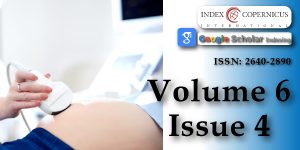Reverse Breech Extraction versus Vaginal Push before Uterine Incision during Cesarean Section with Fully Dilated Cervix and Impacted Fetal Head
Main Article Content
Abstract
Purpose: To compare between the two commonly used methods to deliver the fetus in emergency cesarean section with fully dilated cervix and impacted fetal head; vaginal push up of the fetal head and reverse breech extraction regarding safety and efficacy.
Methods: A retrospective observational study was conducted 152 women underwent emergency CS with fully dilated cervix and impacted fetal head were divided into two groups; Group 1, vaginal push (n = 96) and Group 2, reverse breech delivery (n = 56). Data variables were collected and analyzed to evaluate whether either method is more safe regarding maternal and fetal outcomes.
Results: There was a significant higher percentage of extension of uterine incision in group 1 (p = 0.002). Also, there were significant higher mean values of operative time and operative blood loss in group 1 (p = 0.008 and 0.015; respectively). On the other hand, there was a significantly shorter uterotomy to delivery time in group 1 (p < 0.001). There was a significantly higher mean value of APGAR score at one minute in group 1 (p = 0.043) but no significant difference between the two groups regarding APGAR score at five minutes, atonic PPH, postoperative blood transfusion and hospital stay.
Conclusion: Vaginal push technique was associated with significantly higher intraoperative maternal morbidity but postoperative maternal morbidity and fetal outcomes were comparable between both groups. Push method (after uterine incision) is still the preferable method and larger studies are required to assess the fetal safety with reverse breech extraction.
Article Details
Copyright (c) 2023 Elsayed Elshamy, et al.

This work is licensed under a Creative Commons Attribution 4.0 International License.
Rice A, Tydeman G, Briley A, Seed PT. The impacted foetal head at caesarean section: incidence and techniques used in a single UK institution. J Obstet Gynaecol. 2019 Oct;39(7):948-951. doi: 10.1080/01443615.2019.1593333. Epub 2019 Jun 19. PMID: 31215269.
Singh M, Varma R. Reducing complications associatedwith a deeply engaged head at Cesarean section: a simple instrument. TOG 2008;10[1]:38-41.
Martino V, Iliceto N, Simeoni U. Occipito-posterior fetal head position, maternal and neonatal outcome. Minerva Ginecol 2007; 59[4]:459-64.
Karasahin KE, Ercan M, Alanbay I, Baser I. Comment on 'Disengagement of the deeply engaged fetal head during cesarean section in advanced labor: conventional method versus reverse breech extraction'. Acta Obstet Gynecol Scand. 2010; 89[6]:849-51.
Murphy DJ, Liebling RE, Verity L, Swingler R, Patel R. Early maternal and neonatal morbidity associated with operative delivery in second stage of labour: a cohort study. Lancet. 2001 Oct 13;358(9289):1203-7. doi: 10.1016/S0140-6736(01)06341-3. PMID: 11675055.
Kadhum T. Head pushing versus reverse breech extraction for delivery of impacted fetal head during Cesarean section. Kufa Med J. 2009; 12:200-205.
Fasubaa OB, Ezechi OC, Orji EO, Ogunniyi SO, Akindele ST, Loto OM, Okogbo FO. Delivery of the impacted head of the fetus at caesarean section after prolonged obstructed labour: a randomised comparative study of two methods. J Obstet Gynaecol. 2002 Jul;22(4):375-8. doi: 10.1080/01443610220141290. PMID: 12521457.
Cornthwaite K, Draycott T, Bahl R, Hotton E, Winter C, Lenguerrand E. Impacted fetal head: A retrospective cohort study of emergency caesarean section. Eur J Obstet Gynecol Reprod Biol. 2021 Jun;261:85-91. doi: 10.1016/j.ejogrb.2021.04.021. Epub 2021 Apr 21. PMID: 33901776.
Berhan Y, Berhan A. A meta-analysis of reverse breech extraction to deliver a deeply impacted head during cesarean delivery. Int J Gynaecol Obstet. 2014 Feb;124[2]:99-105.
Lenz F, Kimmich N, Zimmermann R, Kreft M. Maternal and neonatal outcome of reverse breech extraction of an impacted fetal head during caesarean section in advanced stage of labour: a retrospective cohort study. BMC Pregnancy Childbirth. 2019 Mar 27;19(1):98. doi: 10.1186/s12884-019-2253-3. PMID: 30917799; PMCID: PMC6437943.
Patwardhan BD, Motashaw ND. Caesarean section. J Obstet Gynecol India. 1957; 8:1.
Chopra S, Bagga R, Keepanasseril A, Jain V, Kalra J, Suri V. Disengagement of the deeply engaged fetal head during cesarean section in advanced labor: conventional method versus reverse breech extraction. Acta Obstet Gynecol Scand. 2009;88(10):1163-6. doi: 10.1080/00016340903214932. PMID: 19925377.
Frass KA, Al Eryani A, Al-Harazi AH. Reverse breech extraction versus head pushing in cesarean section for obstructed labor. A comparative study in Yemen. Saudi Med J. 2011 Dec;32(12):1261-6. PMID: 22159381.
Menticoglou S. Delivering the Impacted Head at Caesarean Section. J Obstet Gynaecol Can. 2016 Mar;38(3):234. doi: 10.1016/j.jogc.2016.02.003. Epub 2016 Mar 8. PMID: 27106192.
Saha PK, Gulati R, Goel P, Tandon R, Huria A. Second stage caesarean section: evaluation of patwardhan technique. J Clin Diagn Res. 2014 Jan;8(1):93-5. doi: 10.7860/JCDR/2014/6709.3782. Epub 2014 Jan 12. PMID: 24596734; PMCID: PMC3939599.
Bastani P, Pourabolghasem S, Abbasalizadeh F, Motvalli L. Comparison of neonatal and maternal outcomes associated with head-pushing and head-pulling methods for impacted fetal head extraction during cesarean delivery. Int J Gynaecol Obstet. 2012 Jul;118(1):1-3. doi: 10.1016/j.ijgo.2012.03.005. Epub 2012 Apr 20. Erratum in: Int J Gynaecol Obstet. 2012 Dec;119(3):292. Pourabolghase, Shabnam [corrected to Pourabolghasem, Shabnam]. PMID: 22521199.
Veisi F, Zangeneh M, Malekkhosravi S, Rezavand N. Comparison of "push" and "pull" methods for impacted fetal head extraction during cesarean delivery. Int J Gynaecol Obstet. 2012 Jul;118(1):4-6. doi: 10.1016/j.ijgo.2011.12.027. Epub 2012 Apr 27. PMID: 22541809.

